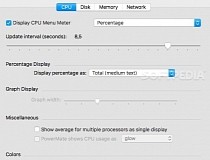

MenuMeters 1.3 is available as a freeware, and it is available for download from the website in both compressed disk image format and source code.
* PowerPC or Intel based Macintosh (Universal Binary). * MacOS X 10.2 (Jaguar), MacOS X 10.3 (Panther), or MacOS X 10.4 (Tiger). Both the arrows and the graph are scaled using a user-selected scaling factor and calculation. * The Net Meter can display network throughput as arrows, bytes per second, and/or as a graph. The Memory Meter menu shows a breakdown of current memory usage and VM statistics. pfpkg file, which tells Mac App Store where to look for the. When you have downloaded them, you’ll have two packages. * The Memory Meter can display current memory usage as either a pie chart, thermometer, history graph, or as used/free totals. Step 1: Download the macOS Sierra package files from their respective URLs. It is hotplug aware, and will show activity on FireWire and USB disks as they are mounted. * The Disk Activity Meter displays disk activity to local disks on the system (anything that is a IOKit BlockStorage driver). It can also graph user and system load and display the load as a “thermometer”. * The CPU Meter can display system load both as a total percentage, or broken out as user and system time. MenuMeters is a open-source benchmark of CPU, memory, hard drive disk, and wired/wireless network usage monitoring tools for MacOS X. The MenuMeters monitors are true SystemUIServer plugins (also known as Menu Extras), in a way, such that they can be reordered using command-drag and remember their positions in the menubar across logins and restarts. Though there may be several other identical programs and applications that perform similar task, but none had quite the features MenuMeters have. 
I was then able to use the High Sierra bootable installer for the clean installation. There is a set of monitoring tool that allows Mac users to monitor the computer’s CPU, memory, Disk and Network, known as MenuMeters. After posting, I found an article that suggested making a bootable installer of an earlier version of the OS (I used El Capitan) and using ONLY the Disk Utility to erase and reformat the drive as Mac OS Extended.






 0 kommentar(er)
0 kommentar(er)
